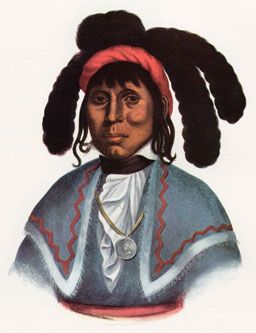Micanopy

Micanopy(c. 1780 – December 1848 or January 1849),[1][2]also known asMick-e-no-páh,Micco-Nuppe,Michenopah,Miccanopa,andMico-an-opa,andSint-chakkee( "pond frequenter", as he was known prior to being selected as chief),[3]was the leadingchiefof the Seminole during theSecond Seminole War.
Biography
[edit]His name was derived from theHitchititermsmiko(chief), andnaba(above), and consequently meaning "high chief" or the like.[3]Micanopy was also known asHulbutta Hajo,(or "Crazy Alligator" ).
Little is known of his early life other than that Micanopy was born near present-daySt. Augustine, Florida,sometime around 1780. He succeededBolekas hereditary principal chief of theSeminolefollowing the latter's death in 1819. The people had amatrilineal kinshipsystem: property and position were passed through the maternal line. Nearly 40 when he became chief, Micanopy soon began acquiring large amounts of land and cattle. As was common practice among elite Seminole, he hired more than 100 fugitive slaves[citation needed]to work his estates during the early nineteenth century. He encouraged intermarriage between the Seminole and blacks. This had been the Seminole tradition since they considered blacks to be human equals, unlike the view by whites at the time. Some of their mixed-race descendants gained influence as an elite among tribal councils (including several war chiefs).[4]
Following the American purchase of Florida fromSpainin 1819 through theAdams–Onís Treaty,and the subsequent appointment ofAndrew Jacksonas territorial governor in 1821, large numbers of American settlers began colonizing northern Florida during the next decade. Micanopy opposed further American settlement of the region. As conflicts arose more frequently between the Seminole and settlers, the Seminole were driven away from the Florida coast and into the extensive wetlands of the interior. By theTreaty of Moultrie Creekin 1823, the Americans seized 24 million acres of Seminole land in northern Florida. The Seminole moved to central and southern territory.[5]
Slaveholders from Florida and neighboring states demanded that the Seminole capture and return slaves who had taken refuge with them. American development of largecotton plantationsin Florida resulted in planters buying more slaves as workers, and some continued to escape the harsh regime. Pressure continued against the tribe, and Americans pressed for removal following passage of theIndian Removal Actin 1830. A group of Seminole chiefs eventually agreed to theTreaty of Payne's Landingin 1832; on May 9, 1832, they ceded more Seminole lands in exchange for a reservation in theIndian Territory(present-day Oklahoma).
While working to negotiate a peaceful resolution between the Seminole and local authorities, Micanopy refused to sign the treaty. He joined younger chiefs, such asOsceola,Alligator,andWild Cat(a nephew of his), in opposing the treaty. They began to organize resistance among the Seminole warriors. Following Osceola's murder of US Indian agent GeneralWiley Thompson,in December 1835 Micanopy (with Osceola) attacked US forces under MajorFrancis Langhorne Dadeand GeneralDuncan Lamont Clinch.Only three soldiers survived what the Americans calledDade's Massacre.Repeated demands were made by settlers for US military action against the Seminole, and the Second Seminole War began.

The Seminole had early success, but the elderly Micanopy became convinced of the futility of war as he realized the large number of American soldiers who could be sent against the Seminole. He surrendered in June 1837 and began negotiating to move his tribe to the Indian Territory, but he was kidnapped by Osceola. In December 1838, Micanopy was captured by GeneralThomas S. Jesup's forces while under a flag of truce, when he had already agreed to sign a peace treaty. This breach of honor by the US was considered an outrage by much of the public, increasing their sympathy toward the Seminole.
Imprisoned atCharlestown, South Carolina,Micanopy was eventually released and sent with around 200 other Seminole to Indian Territory. They were initially put underCreek Nationauthority, although the people had long been independent.
Although Micanopy attempted to reestablish the Seminole as independent, he never regained his previous power. In 1845, he was one of the signatories of a treaty with the US, which gave the Seminole of western Florida semi-independence from theCreek Nationin Indian Territory. The treaty provided for full Seminole independence to be granted in 1855. Micanopy died atFort Gibsonon January 2, 1849.
As the Seminole had amatrilineal kinshipsystem, his sister's son, Jim Jumper, succeeded Micanopy as principal chief. The Seminole gradually re-established theiritalwaand traditional organizations in Indian Territory. Jim Jumper was succeeded after his death four years later by his brother,John Jumper,who led the tribe until after the American Civil War. At that time, the United States required tribes that supported the Confederacy to make new treaties, providing for emancipation of all slaves and granting those who wanted to stay with the Seminole equal rights as citizens.
Legacy and honors
[edit]European Americans namedMicanopy, Floridaafter the chief.[6]It was founded at the site of the chief's capital town,Cuscowilla.
Notes
[edit]- ^Kevin Mulroy (September 2003).Freedom on the Border: The Seminole Maroons in Florida, the Indian Territory, Coahuila, and Texas.Texas Tech University Press. p. 47.ISBN978-0-89672-516-4.
- ^Edwin C. McReynolds (1957).The Seminoles.University of Oklahoma Press. pp.260.ISBN978-0-8061-1255-8.
- ^abSimpson, J. Clarence (1956). Mark F. Boyd (ed.).Florida Place-Names of Indian Derivation.Tallahassee, Florida: Florida Geological Survey.
- ^Hatch, Thom (2012).Osceola and the Great Seminole War.New York: St. Martin’s Press. pp. 30–35.
- ^Hatch, Thom (2012).Osceola and the Great Seminole War.New York: St. Martin’s Press. p. 184.
- ^Frisaro, Freida Ratliff (Feb 21, 1988)."Indian heritage runs deep throughout Central Florida".Ocala Star-Banner.p. 63.Retrieved6 June2015.
References
[edit]- Johansen, Bruce E. and Donald A. Grinde, Jr.,The Encyclopedia of Native American Biography,New York: Henry Holt and Company, 1997.
- Markowitz, Harvey., ed.,Magill's Choice American Indian Biographies,California: Salem Press Inc., 1999.
- Sattler, Richard A. "The Seminole in the West",Handbook of North American Indians: Southeast,Vol. 14, ed. William Sturtevant, Washington, DC: Smithsonian Institution, 2004
